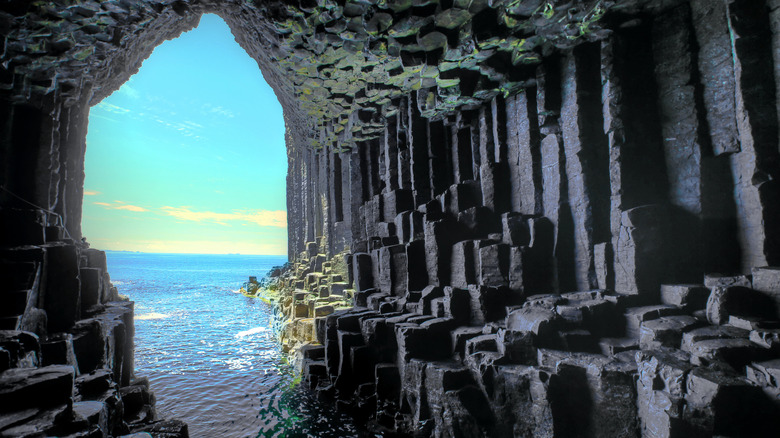Scotland's Cathedral Of The Sea Is A Wondrous Art Inspiring Cave You Can Walk Through
Centuries before social media, a botanist who explored the world with Captain Cook convinced everyone from Queen Victoria to Jules Verne to make the journey to a cave on a remote Scottish island. In 1772, Joseph Banks wrote about the otherworldly basalt columns and magnificent acoustics of Fingal's Cave, inspiring the poet John Keats to see this geological wonder for himself and call it the "Cathedral of the Sea."
On the tiny (a half mile by a quarter mile), uninhabited Hebridean island of Staffa, Fingal's Cave was formed millions of years ago by the same lava flow that created Northern Ireland's awe-inspiring Giant's Causeway. Its hexagonal columns rise 65 feet and can be compared to the pipes of an organ, giving one the feeling of being in a cathedral. The crashing waves -– the dramatic display of nature that carved Fingal's Cave – are sometimes powerful and deafening and at other times gentle and echoing as they ebb and flow in and around this 269-foot cave. When conditions are right, it's possible to walk or kayak into the cave and even swim with the massive basking sharks that come to this area to feed in summer.
The waters around Staffa are a Marine Protected Area, a Special Area of Conservation, and part of the Hebridean Whale Trail. The island itself is a nature reserve known for the large puffin colony that nests in its cliffs in summer. Another celebrated sea cave is in Italy, Capri's Blue Grotto.
Art the cave inspired
Some of the world's most well-known writers, artists, and composers traveled to Staffa and created works of art that increased the fame of Fingal's Cave and perpetuated its mysterious allure. A generation after Banks raised awareness about the cave, Felix Mendelssohn trekked to the island with his mother whose bucket list included seeing Fingal's Cave. At the age of 20 in 1829, Mendelssohn wrote the "Hebridean Overture," a beautiful and moving composition that embodies the wild nature of the cave with surging strings, crashing cymbals, and layered instruments that ebb and flow like the waves.
In 1831, the English artist JMW Turner painted "Fingal's Cave," a dark composition with a steamship that Sir Walter Scott included in his poetry collection "Lord of the Isles." Scott wrote of the cave that it was "one of the most extraordinary places I ever beheld" (via Hidden Scotland).
William Wordsworth visited the cave in 1833 and wrote in the "Cave of Staffa" sonnets that "the sovereign Architect / Has deigned to work as if with human Art!" In the same poem, "Staffa," in which he refers to the cave as the "cathedral of the sea," Keats says of the god of the sea "Here his mighty waters play / Hollow organs all the day."
Visiting Fingal's Cave
There are numerous ways to get to Staffa from April to October — boats don't usually operate in the other months. Visit in summer for the best chances of good weather and seeing wildlife like puffins and other sea birds and a variety of whales. Staffa Tours, which operates out of Fionnphort on Mull, is one of several experienced tour operators. Staffa Trips leave from Iona. An option from Oban on the mainland is West Coast Tours, and the Caledonian MacBrayne ferry also travels to Staffa but its routing is convoluted.
Once off the boat, follow the concrete path at the landing area and make your way around the side of the cave, walking on uneven sections of the cave's natural pillars. There's a wire handrail to hold onto. You can enter the narrow mouth of the cave well above water level, continuously walking on the broken stone-like pillars. It is not possible to walk the entire length of the cave as it is slippery and not safe. Retrace your steps and then climb ladder-like steps up the side of the island to look for puffins and take in the 360-degree views of the ocean. The sea can be rough and the weather is often windy and/or rainy. Dress in layers including an outer layer that is wind and waterproof. Sturdy shoes with good traction are an absolute must. Landing on the island is never guaranteed as sea swells and heavy rain and wind can be dangerous.
Staffa is one of more than 100 islands in the Hebrides off the west coast of Scotland. Explore beyond Staffa to see Skye (known for scenery and hiking), Islay (whisky), Mull (gin, whisky, and sea eagles), and Iona (Christian history). They're the most well-known of the Inner Hebrides while Lewis and Harris are the most famous of the Outer Hebrides for making tweed and for the ancient Callanish Stones.


